« Demobilizations: troubling official data about a troubled process | Main | Notes from a House hearing on Latin America »
June 24, 2006
The UN's data on Colombian coca-growing
The UN Office on Drugs and Crime released its annual Andean Coca Survey on Tuesday. It found an 8 percent increase in the amount of coca grown in Colombia in 2005. Similarly, U.S. estimates released in April found either an increase in 2005, or an adjustment to reflect more area under measurement.
If you want to know about drug-crop cultivation in Colombia and the rest of the region, this document is absolutely required reading. How much coca was grown in each department of Colombia last year? How much land was fumigated in each department? How extensively do alternative development programs cover affected populations? What prices are coca-growers are being paid for their product? For answers to these and many other questions that an informed counter-drug strategy must answer, this report is the only source available.
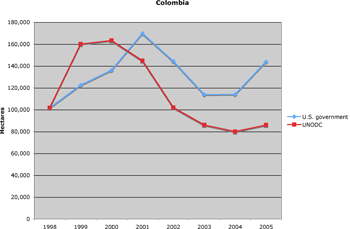 |
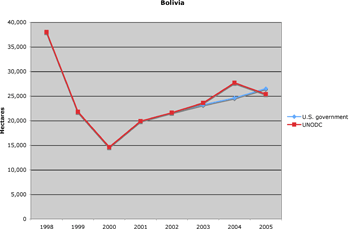 |
 |
The U.S. government, by contrast, just provides an overall number of hectares of coca estimated to have been grown in each country, and little else. The State Department's annual International Narcotics Control Strategy Reports, released each March, are not useful for discerning trends, since they either omit or play down information that might indicate that the strategy is not working.
For its part, the UNODC provides its own coca-growing estimates for Bolivia, Colombia and Peru. Like the U.S. numbers, these estimates are based on satellite data. The divergence between U.S. and UN numbers is increasing, however: the U.S. estimate for Colombia is now two-thirds higher than the UN number, and while UN figures showed decreases in Bolivia and Peru last year, the U.S. data show coca cultivation on the rise in both countries. If this makes anything clear, it is the fact that we have only a vague idea of how much coca is being grown in the Andes.
Because the UN document makes it easier to discern trends, it is hard not to notice one in particular: the current anti-drug strategy, which favors forced eradication over governance and development, has failed utterly.
Of course, the UNODC - which gets much funding from the United States, and whose crop-monitoring program works in tandem with Colombia's National Police - is not going to argue that aerial fumigation has failed. In fact, the UN agency contends that fumigation has somewhat reduced Andean coca-growing over the past five years (a contention that U.S. statistics, which show coca acreage holding steady throughout the Andes, do not uphold).
However, its latest report offers abundant evidence that the current strategy is no longer reducing coca-growing in the Andes, and is unlikely to do so in the future. "Coca Cultivation in Andes Stabilizes in 2005," reads the UNODC press release accompanying the report. Their point is that current massive levels of U.S. aid for fumigation and interdiction are able to bring only stability at current levels of coca cultivation. More reductions in coca-growing are unlikely, and a region-wide increase is a distinct possibility.
What is needed now, the UN agency argues, is much more donor-country investment in rural development. "Our aid efforts need to be multiplied at least tenfold in order to reach all impoverished farmers who need support," says UNODC Director Antonio Mario Costa.
Here are some of the report's most interesting findings.
- In response to fumigation, coca cultivation continues to move geographically within Colombia. As fumigation intensified in Nariño and in the "Plan Patriota" zone in southern Colombia, coca-growing increased elsewhere. Putumayo department, which was the epicenter of coca cultivation when "Plan Colombia" began in 2000, registered its first increase in coca-growing since that year. Paramilitary-controlled zones in Córdoba, northern Antioquia and southern Bolívar all increased, as did zones under guerrilla influence such as Meta's Macarena National Park and the Uva River basin in Vichada, the sparsely populated department near the Venezuelan border. In all, the UN survey detected coca in 23 of Colombia's 32 departments.
- Massive amounts of spraying in a single department appear to achieve short-term reductions, which don't appear to be sustainable without a government presence on the ground.

Large-scale spraying in 2001-2002 reduced coca-growing in Putumayo. Once spraying declined in this poor, neglected department, reductions ceased, and coca-growing in fact doubled last year in Putumayo. The amount of coca remains far below 2000-2001 levels, though, largely due to the presence of alternative-development programs. The new Putumayo coca, according to UNODC, is being planted in the department's far western foothills, near the borders with Nariño and Cauca - a region that had little coca before, but has little state presence or alternative development investment. 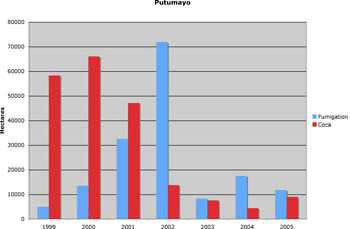

In vast, sparsely populated, nearly ungoverned Vichada, far-flung coca cultivation has made spraying difficult, and measures of the crop have increased. A similar dynamic has happened in Meta, though some of the increase there owes to planting in the Macarena National Park. 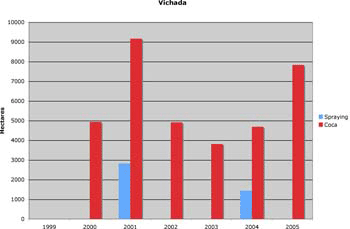

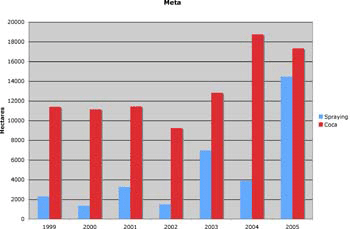

In Nariño and Antioquia, increased spraying has yet to affect coca-growing significantly. 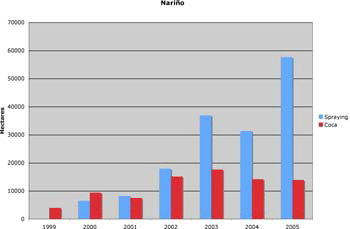



In Caquetá, Guaviare and Norte de Santander, coca has been reduced. Some of this owes to high levels of spraying, though these have been tapering off. Much credit in fact goes to a greater presence of government personnel on the ground. In Caquetá and Guaviare, those personnel are mostly soldiers participating in the "Plan Patriota" military offensive; their presence is temporary, and we can expect coca to increase if their numbers are drawn down. In Norte de Santander, the UNODC gives robust alternative-development programs the credit for the sharp reduction in coca cultivation. 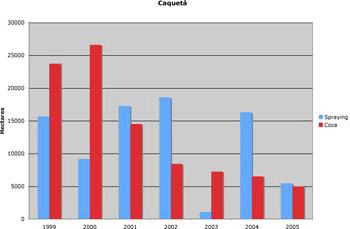

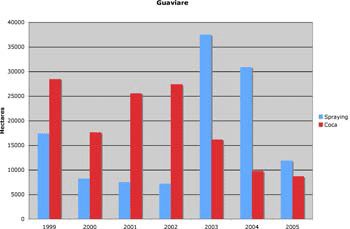

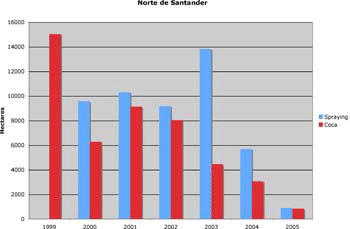
- Farmers have been re-planting coca at a staggering rate. Fumigation, in the absence of other alternatives, is not deterring coca cultivation. 44 percent of the coca fields the UNODC satellites detected in 2005, making up 61 percent of all coca detected, did not exist in 2001-2004.
- Coca fields are getting even smaller. The average coca plot that UNODC detected last year was 1.13 hectares, down from 1.3 in 2004 and 2.05 in 2000. "A possible explanation," according to the report, "could be that farmers are reducing the size of their coca fields to avoid detection and aerial spraying."
- Polling of coca-growers makes apparent that spraying is merely an inconvenience, disrupting but not stopping their income stream from coca. According to the report, "Once their fields have been sprayed, the farmers responded that in 45% of the cases they would just wait for the coca plants to recover, in 20% of the cases they would cut the damaged coca plants, in 12% of the cases they would re-plant their fields, while the remaining 23% adopted for a combination of these solutions." According to UNODC, farmers can prune sprayed coca bushes to a height of one foot "to obtain a renewal of the bush in about six months." The report also notes that "when heavy rain occurs or bushes are washed by the farmers immediately after the spraying, the loss in coca leaf can be reduced and the crop recovered quickly."
- New UNODC research indicates that more cocaine is being extracted from the same amount of coca. The UN had previously estimated that a hectare of coca yielded about 4.7 kilograms of pure cocaine each year. They have revised this estimate to 7.7 kilograms. "Based on this data, the total cocaine production in Colombia for 2005 reached 640 metric tons cocaine," reads the report; this is higher than the U.S. government estimate of 545 tons. Increased yields, the UNODC indicates, "may help to explain why the price and purity of cocaine have remained steady on the streets of consuming countries despite the overall reduction in world supply."
-
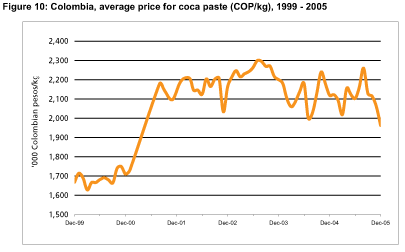 Prices paid for coca paste in Colombia are not rising, which means that fumigation is not reducing coca-leaf supplies. Prices in 2005 rose in dollar terms, but shrank in peso terms (the dollar weakened against the peso last year). "After a sharp increase in 2001, which can be seen in connection with the successful efforts of governments to stop the trafficking of cocaine base from Peru to Colombia, prices for coca paste in Colombia tend to oscillate around 2,100,000 Colombian Pesos (US$ 900) per kilogramme."
Prices paid for coca paste in Colombia are not rising, which means that fumigation is not reducing coca-leaf supplies. Prices in 2005 rose in dollar terms, but shrank in peso terms (the dollar weakened against the peso last year). "After a sharp increase in 2001, which can be seen in connection with the successful efforts of governments to stop the trafficking of cocaine base from Peru to Colombia, prices for coca paste in Colombia tend to oscillate around 2,100,000 Colombian Pesos (US$ 900) per kilogramme."
- Coca farmers - who are hit hardest by the U.S.-supported focus on eradication - are not rich. The UNODC estimates that 68,600 families grow coca, a total of about 336,150 people (0.8 percent of Colombia's population). Each family takes in about $12,300 per year, minus all production costs (herbicides, pesticides, fertilizers, wages for coca-pickers, and of course extortion payments to armed groups). Notes the report, "It seems that even the gross per capita income derived from coca cultivation is well below the average GDP per capita, confirming that coca farmers belong the economically worse off part of the population. The figures for Peru and Bolivia show a similar scenario." The UNODC adds, "In most cases, the emergence of illicit crops does not significantly increase peasants’ income, but can improve their basic subsistence when other income generating activities are not present."
- Rural development offers the only way out. The UNODC makes this point in every one of its annual coca surveys: "There is evidence that giving farmers alternative sources of income so they do not have to grow coca can work…. However, the scale is still very small and needs to be multiplied at least tenfold in order to reach all impoverished farmers who need support. This is a major undertaking, but it could reduce poverty and the world supply of cocaine at the same time." Despite this evidence, alternative development is underfunded and opportunities are scarce. "In Colombia, a study by the Colombian government and UNODC revealed that only 9% of the coca farmers interviewed reported having received any kind of assistance to stop growing coca plants."
The present mix of policies - heavy eradication, little development aid - has brought such a persistent and frustrating lack of results, common sense would dictate that the United States and other donor countries immediately shift their strategies and boost alternative development. Common sense, however, has not driven this policy.
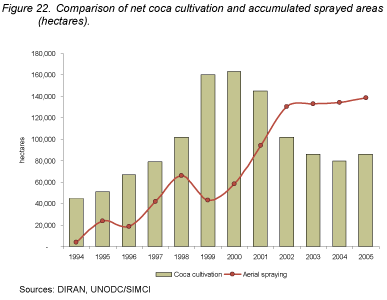 The UN's estimates tell us that between 1999-2000 and 2003-2004, a tripling of fumigation cut Colombian coca cultivation in half. (Fumigation went from about 40,000 hectares per year to 130,000; coca went from about 160,000 hectares to 80,000.)
The UN's estimates tell us that between 1999-2000 and 2003-2004, a tripling of fumigation cut Colombian coca cultivation in half. (Fumigation went from about 40,000 hectares per year to 130,000; coca went from about 160,000 hectares to 80,000.)
In the absence of alternative development, then, what would it take to reduce Colombian coca by half again, to 40,000 hectares? Another tripling of fumigation, to 400,000 hectares (and well over half a billion dollars) per year? Would it take a further tripling (1.2 million hectares sprayed, $1.5 billion) to halve it again, to 20,000 hectares?
This strategy has run its course. Rural development, with a state presence in neglected areas - along with more demand-reduction in consuming countries like the United States - offers the only way out of the dead end that U.S. fumigation has proven to be.
The UNODC's report won't say that. But its findings point pretty clearly in that direction.
Posted by isacson at June 24, 2006 7:37 PM
Trackback Pings
TrackBack URL for this entry:
http://ciponline.org/cgi-bin/mt-tb.cgi/254
Comments
Post a comment
Thanks for signing in, . Now you can comment. (sign out)
(If you haven't left a comment here before, you may need to be approved by the site owner before your comment will appear. Until then, it won't appear on the entry. Thanks for waiting.)